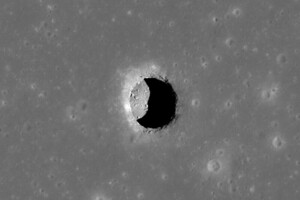Perhaps the people who arrive on Earth's satellite will have to live in caves.

Scientists working with NASA, with the help of of the Lunar Reconnaissance Orbiter (LRO) found shaded places on the moon, the temperature of which always fluctuates within the limits of a comfortable 17 degrees Celsius for humans, reports Phys.org.
These depressions can lead to caves beneath the surface of the Moon and provide reliable places for explorers to base themselves here. They are more stable than the surface of our planet's satellite, which heats up to 127 degrees Celsius during the day and cools down to -173 degrees at night.
Also read: NASA postpones launch of rover to search for water on the moon
< p>The craters on the moon were first spotted in 2009, and since then scientists have wondered if they lead to caves that could be used as shelters. They can also provide protection against cosmic rays, radiation, and micrometeorites.
“About 16 of the more than 200 pits are likely to be collapsed lava tubes,” said Tyler Horvath, a doctoral student in planetary sciences at UCLA who led the new study.
Lava tubes, which are also found on Earth, are formed when red-hot lava flows under a field of cooled lava, or a crust forms above it. As a result, a long hollow tunnel appears. If the ceiling of such a pipe collapses, a pit opens that can lead to the remaining part, which resembles a cave.
Two of the most prominent lava tubes have protrusions that lead to pits or cavities. There is also evidence that the protrusion of another one could lead to a larger cave.
“Humans evolved by living in caves, and we could return to caves when we live on the moon,” said one of the authors of the new research by David Page.
In the course of the study, Horvath and his colleagues studied one cylindrical depression about 100 meters deep in an area of the moon known as the Sea of Tranquility. To analyze the thermal properties of the soil and lunar dust, they also plotted the temperature in the depression over time.
They found that the temperature in the depression fluctuates slightly during the lunar day, staying around 17 degrees Celsius. If the cave extends from the bottom of the lava tube, as indicated by images from the Lunar Reconnaissance Orbiter, it should also maintain a comfortable temperature.
Scientists believe that the stable temperature of the lava tubes is ensured by their shading, which limits heating during the day and prevents it loss at night A day on the Moon lasts about 15 Earth days, during which the surface of the Earth's satellite is constantly exposed to sunlight. At this time, it is hot enough to boil water on it.
Cold lunar nights also last about 15 Earth days.
Formerly NASA Lunar Reconnaissance Orbiter (LRO) discovered on the Moon the crash site of a mysterious rocket that crashed into the Earth's satellite on March 4. In the pictures taken on May 25, you can see the double crater formed by the impact.




